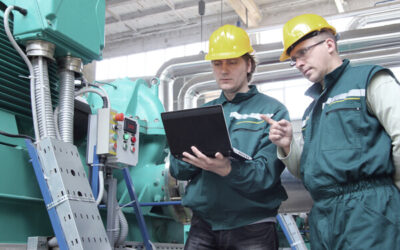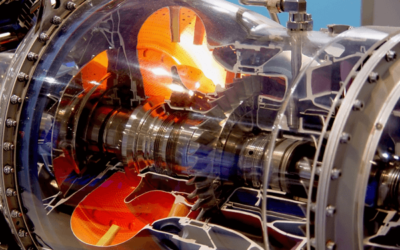Energy production companies have operated under similar conditions for nearly a century. Oil and gas extraction, refinement, and subsequent energy generation have not changed dramatically since their inception. Granted, new technology has made these processes more efficient, but they are still overwhelmingly analog businesses. It’s time for this sector to make the leap and complete a digital transformation. The most successful players in the industry have already done so. How can your company make the transition to a digital environment?
Blog
All Content
Industrial Automation: Addressing Rising Power Consumption
All Content, Digital Manufacturing
Industrial businesses are constantly squeezed by ever-tightening margins as rising costs threaten profitability. However, many companies struggle to find ways to cut costs while still holding onto their value human capital. Given that raw material costs are entirely out of your control, and your operations require constant financial support, where can you find savings? Optimizing your power consumption with industrial automation can have a major impact on your bottom line and help your business weather future events.
New technologies have made it possible for industrial operations to reach greater energy efficiency levels without making major changes to their workflow. Best of all, automation technology provides other benefits besides reduced energy use.
7 Reasons to Get Digital Transformation Consulting
All Content, Digital Manufacturing, Research
Going completely digital should be every company’s goal going forward. Many businesses have already seen the value of going digital and are in the middle of their transition. However, there are many obstacles to your digital transformation. If you don’t address these before you implement new processes, you could create problems that will be much harder to solve in the future. That’s where digital transformation consulting comes in. With the help of an experienced team, you too can go digital.
AI-Powered Trends in Machine Condition Monitoring
All Content, Artificial Intelligence, Digital Manufacturing, Research
Artificial intelligence is more accessible than ever before. It’s also more useful than ever thanks to new applications for businesses of all kinds, including industrial companies. One such application of AI is machine condition monitoring. By tracking a machine’s condition through sensors, AI-based software can predict when a machine will need maintenance and even take action to prevent failures. We expect this technology to continue to spread as more companies adopt it. Here are some of the trends to follow.
What Are the Instruments Used in Condition Monitoring?
All Content, Digital Manufacturing, Research
A reliable condition monitoring system can completely transform your industrial operation. You can optimize your maintenance schedule by focusing on the machines that actually need maintenance rather than following a routine that may result in redundant efforts. Even better, you can schedule maintenance for more convenient times. In addition, you can predict when machines are likely to need repair or replacement by gathering data over time. Monitoring your machines’ condition is essential to gain a competitive advantage.
While some modern machines have monitoring components built in, you don’t need to upgrade your factory floor. You can retrofit older machines with specialized instruments at a fraction of the price. An investment in condition monitoring technology yields significant returns due to the relatively low initial expense and massive potential for long-term savings. So, what do you need to make it possible? Let’s look at the most important instruments in a monitoring system.
Unlock Effective Condition Monitoring with Automated Vision Systems
All Content, Digital Manufacturing, Research
Automation continues to press onward thanks to advances in computing technology. Thanks to the proliferation of artificial intelligence, specifically machine learning, visual data processing has never been more powerful. Essentially, computers can see now. And they can use what they see to make decisions faster than any human could. With machine vision systems, you can bring that technology to your business. To better understand these systems, let’s take a closer look at how they work.
Automated Test Equipment: How Will it Benefit You?
Aerospace and Defense, All Content, Digital Manufacturing, Research
Before you can bring a new industrial solution to market, it has to be vetted thoroughly. Similarly, to prove that your company can handle massive installations for the public sector, you’ll need to demonstrate your capacity. Expanding your own operations calls for pilot designs and exploratory testing to ensure that your goals are feasible. Regardless of the exact situation, testing your systems and their components is essential. R&D and QC processes can be greatly accelerated with automated test equipment.
Your Biggest Roadblocks to Successful Digital Transformation
All Content, Digital Manufacturing, Research
By now, most businesses understand that they need to digitize their operations as much as possible. Going digital generates data that can be analyzed to refine processes and improve outcomes. It also opens the doors to automation and makes AI much more powerful. So, if the benefits are so clear, why do so many businesses still lag behind? Our experience with digital transformation consulting has revealed several obstacles that are often unaccounted for. However, we have solutions for these problems.
Predict Problems Before They Happen With AI Equipment Monitoring
All Content, Artificial Intelligence, Digital Manufacturing, Research
Artificial intelligence is no longer a sci-fi trope, it’s real and it’s here. Even though you mostly hear about AI in the service sector, engineers have found ways to leverage AI for industrial businesses as well. One of the most effective applications for AI in industry is equipment condition monitoring. You don’t even need to buy new equipment to access this powerful technology. Here’s how it works and what you need to take your business into the future.
Can Digital Transformation Transform the Supply Chain?
All Content, Digital Manufacturing, Research
The last two years have completely shaken the supply chain. Disruptions in shipping and port operations have left container ships lingering off coasts worldwide. Production of complex components like computer chips and mobile phones has been stifled by delays in raw material delivery. Disruptions are to be expected, but the resulting negative effects can be prevented with a digital transformation of the supply chain. Let’s take a closer look at what this transformation entails.
AI’s Impact on Aerospace in the Next Decade
Aerospace and Defense, All Content, Artificial Intelligence, Research
Artificial Intelligence (AI) is much more than a buzzword. Machine learning algorithms coupled with massive databases are making it possible for companies to surge forward in a fraction of the time it would take engineers with just a pen and paper. In particular, the aerospace industry is beginning to tap into the potential of AI. We expect some major leaps forward in the next decade thanks to AI. Here are some of the breakthroughs you can expect to see.
What Takes Place During the Digital Transformation Process?
All Content, Digital Manufacturing, Research
The digital revolution is here and businesses that want to survive need to keep up with the digital transformation. So how does this process work? The goal of this process is to keep your business adaptable to changes in the status quo by continually upgrading your technology and making changes to the organizational elements of your business to keep up with demand. But that’s just the tip of the iceberg.












